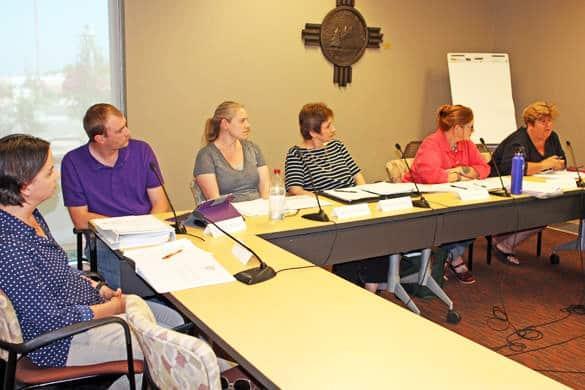 Community Development Department Advisory Board members from left, Jamie Kennedy, Aaron Walker, Catherine Ozment, Denise Derkacs, Andrea Pistone and Cindy Hollabaugh attend their first meeting Aug. 20. Photo by Kirsten Laskey/ladailypost.com
Community Development Department Advisory Board members from left, Jamie Kennedy, Aaron Walker, Catherine Ozment, Denise Derkacs, Andrea Pistone and Cindy Hollabaugh attend their first meeting Aug. 20. Photo by Kirsten Laskey/ladailypost.comDuring the first meeting of the Community Development Department (CDD) Advisory Board, members elected a chair and vice chairperson as well as began drafting the advisory board’s work plan.
The meeting was Aug. 20 in the boards and commissions room at the Los Alamos County Municipal Building.
One of the first orders of business was to elect a chair and vice chairperson. Board members, which include: Jamie Kennedy, Aaron Walker, Catherine Ozment, Denise Derkacs, Andrea Pistone and Cindy Hollabaugh elected Ozment as chair and Pistone as vice chair. Board member William Dai was absent.
Additionally, the board reviewed instructions for creating a work plan and began drafting its plan. CDD Director Paul Andrus and Ozment will work together to synthesize the board’s notes and report back at the September meeting. The work plan to due to be presented for County Council approval in October.
Ozment, who also serves on the Arts in Public Places board, explained to those unfamiliar with board work plans that the outline they received is a standard template. She added creating and submitting work plans for Council approval is an annual process for all boards and commissions.
Andrus said the draft work plan featured elements from the ordinance that Council passed for the CDD Advisory Board, specifically the goals the Council would like the board to accomplish. He added that staff didn’t venture outside the ordinance because the hope is the CDD Advisory Board will put its own mark into the work plan.
Regarding the first portion of the draft plan, which addresses the board’s overall goals, Derkacs suggested looking at past notices of violations (NOV) so the board would know what has been done as well as have background information. She further added it would be good to get this information at the “macro-level” so the board could have the “big picture.”
Pistone said she felt reviewing six months of NOVs would provide a good example of what the County and public would like to see in notices. It also will help the board identify what is “ridiculous” in violations.
Without that information, Pistone said she didn’t think she could adequately address changes.
Kennedy said she was concerned that looking at six months’ worth of data might just result in the board reviewing information forever. She recommended starting with two to four months of data and possibly building from there.
County Councilor and Board Liaison Antonio Maggiore pointed out the number of NOVs would be reduced during the last few months due to the 60-day moratorium on the code enforcement program that was approved in April.
Andrus assured the board they will get the information.
“We’ll make it happen,” he said.
Ultimately, the board requested three sets of information: monthly notice of violation collections and historic data including NOVs two to three months prior to the moratorium and the IPRA requests made by citizen groups prior to the Los Alamos County Citizens in Action’s presentation to Council in November.
Moving forward with future NOVs, Ozment wondered what procedure the board would like to see. Pistone said she felt the board should receive a report of NOVs two weeks prior to the board meeting. It also was agreed the board should be given a deadline to submit questions about the reports to Andrus.
Ozment added she felt the board should also identify positives in the code enforcement program.
“I think it is really important for us to provide that feedback as well,” she said.
Regarding tools the board needs to make recommendations, Pistone said, “I need to learn about the process within the CDD.” Specifically, she said she would like to know what code enforcement officers do, what they look for and how they operate.
The board felt it was important to review all the information before making any recommendations. Derkacs said she would like to see additional chapters in the code ordinance as well as code enforcement policies from communities with populations similar to Los Alamos.
Derkacs said the board has a significant learning curve and needs to review this initial information.
“I think we all have a lot to digest before making recommendations,” she said.
A good start to getting this initial information, the board agreed, was to have a presentation from CDD staff.
The next CDD Advisory Board meeting is Sept. 17.

